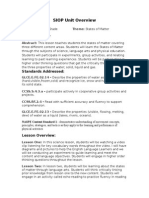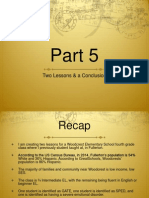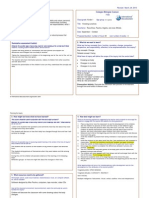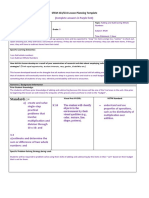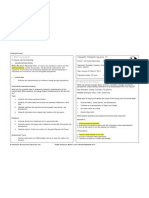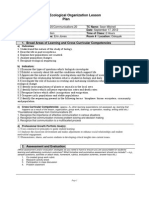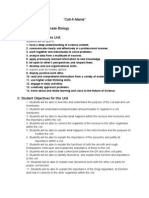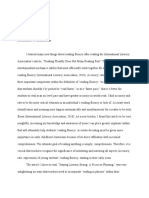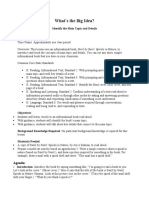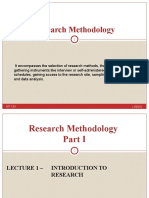Fifth Grade s5l2 Traits Lesson Plan
Fifth Grade s5l2 Traits Lesson Plan
Uploaded by
JordanCopyright:
Available Formats
Fifth Grade s5l2 Traits Lesson Plan
Fifth Grade s5l2 Traits Lesson Plan
Uploaded by
JordanOriginal Title
Copyright
Available Formats
Share this document
Did you find this document useful?
Is this content inappropriate?
Copyright:
Available Formats
Fifth Grade s5l2 Traits Lesson Plan
Fifth Grade s5l2 Traits Lesson Plan
Uploaded by
JordanCopyright:
Available Formats
Fifth Grade Unit 2 – Traits
Elaborated Unit Focus
In this unit, students will learn the difference between instincts and learned behaviors. They will also distinguish
between acquired physical traits and inherited ones by comparing and contrasting.
At the end of this unit, students will debate the question “What makes you who you are?” and effectively
communicate their position using research and data that they have collected about themselves,
classmates, etc.
Role: A member of a debate team
Audience: students their age
Culminating Task Scenario: Students will choose a position as to whether inherited traits or learned behaviors have the most
influence in making someone who they are.
Product: A written essay and the debate
OR
Survival Guide Project- (See Description Below)
S5L2. Obtain, evaluate, and communicate information showing that some characteristics of organisms are
GSE for Science inherited and other characteristics are acquired.
(standards and
elements)
a. Ask questions to compare and contrast the characteristics of instincts and learned behaviors.
b. Ask questions to compare and contrast inherited and acquired physical traits. (Clarification statement:
Punnett squares and genetics are taught in future grades.)
Cross-cutting Concepts 1. Patterns. Observed patterns of forms and events guide organization and classification, and they prompt questions
Troup County Schools 2017-18
Fifth Grade Science
Quarter 1
about relationships and the factors that influence them.
2. Cause and effect: Mechanism and explanation. Events have causes, sometimes simple, sometimes multifaceted. A
major activity of science is investigating and explaining causal relationships and the mechanisms by which they are
mediated. Such mechanisms can then be tested across given contexts and used to predict and explain events in new
contexts.
6. Structure and function. The way in which an object or living thing is shaped and its substructure determine many
of its properties and functions.
Literacy standards
ELAGSE5RI4: Determine the meaning of general academic and domain-specific words and phrases in a text relevant
to a grade 5 topic or subject area.
ELAGSE5RI7: Draw on information from multiple print or digital sources, demonstrating the ability to locate an
answer to a question quickly or to solve a problem efficiently.
ELAGSE5RI10: By the end of the year, read and comprehend informational texts, including history/social studies,
science, and technical texts, at the high end of the grades 4-5 text complexity band independently and proficiently.
Connection to Literacy ELAGSE5W2: Write informative/explanatory texts to examine a topic and convey ideas and information clearly.
Standards for Science
(reading and/or
ELAGSE5W4: Produce clear and coherent writing in which the development and organization are appropriate to task,
writing) purpose, and audience.
ELAGSE5W7: Conduct short research projects that use several sources to build knowledge through investigation of
different aspects of a topic.
ELAGSE5SL1: Engage effectively in a range of collaborative discussions (one-on-one, in groups, and teacher-led) with
diverse partners on grade 5 topics and texts, building on others’ ideas and expressing their own clearly
ELAGSE5SL4: Report on a topic or text or present an opinion, sequencing ideas logically and using appropriate facts
and relevant, descriptive details to support main ideas or themes; speak clearly at an understandable pace.
Troup County Schools 2017-18
Fifth Grade Science
Quarter 1
Instructional Activities
Phenomenon: Proboscis Monkey are excellent swimmers, yet they choose to jump across the river. Why do you think
Available
that is?Literature
In the to
video, are the monkeys demonstrating a learned behavior
Traits of Living Things, Science Support Readers or is it an instinct to jump across the river?
enhance instruction
Secondary Phenomenon:
Lesson 1: Introduction
● Provide students with pictures of various mothers and their offspring. Students will examine the photos to compare &
contrast physical traits that are similar & different (legs, eyes, ears, tail, color, body shape, head shape, fur, height)
● Have students look at the picture of the dog & puppies (or the cat/kittens) and discuss the day in the life of that animal.
FurtherEssential Questions
examine the picture of the dog and Related
and discuss Supporting/Guiding
daily activities/actions they would doQuestions
to survive (how do they find/get
food, how they interact/ where & how they sleep, etc.) Have them list at least 10 things that a dog would do during the day
Essential Question 1 1. What would happen if we all had the same characteristics (inherited and or/acquired)?
● Take that information and organize it into 2 categories: Born knowing how to do this/ Learned after birth.
● Students should 1. begin to identify
What instinct and learned behaviors even though they may not know the terms yet.
are traits/characteristics?
● Questions 2. Are there different types of characteristics?
Discuss as a class and clear up any misconceptions from the activity.
Guiding
3. How do our traits affect who we are?
Lesson 2: Demonstration
4. Are our characteristics influenced by our environment?
● Have students create a list of 20 behaviors that they do throughout the day (waking up, brushing teeth, walking, etc.) Let
● I can distinguish between traits that are inherited and acquired physical traits.
them have a discussion about which of these activities are learned and which are they born knowing how to do (instinct). If
Learning Targets ● I can compare and contrast inherited traits and acquired physical traits.
they say learned, who did they learn them from?
● I can compare and contrast instinct and learned behaviors.
● Introduce the words instincts and learned. Let them discuss what they think each word means. Thinking back to our activity
yesterday and our list today, how can we label our behaviors? Have them label each of their behaviors with an I (instinct) or
an L (learned).
● Put students into groups of two and pass out a ruler to each pair. Explain to students that they will be doing an activity
called “Ruler Catch” in which one student will drop a ruler between the thumb and forefinger of another student. The other
student will attempt to catch the ruler before it drops past their fingers. Let them try several times. After both students have
had the opportunity to “learn” how to catch the ruler, ask: What happened? Why do you think the activity got easier after
practice? What could we call Other Discussion
this behavior? and sure
(Make Formative
studentsAssessment Ideas
understand that they just learned a behavior.)
Discussion: ● (Example of an instinct)
● Debate●which
Go back to the list that was
instinct-hibernation madeinactive
(staying at the beginning
during winterof class and take
months) another(always
or homing look. Isknow
therehow
anything that
to find was
your written
way home)down
is more
that you may need to change from an instinct
important to a bear’s survival. Give reasons for your argument.to a learned behavior? A learned behavior to an instinct?
● grizzly
● A mother Make sure
bearthey understand
instinctively that
raises anprotects
and instinct her
can young
also becubs.
called an after
Yet, innate behavior.
a mother Remind
iguana laysstudents
eggs, herwhat
job astraits are and
a mother that
is finished.
traits
Explain why youcan besome
think physical and behavioral.
animals Have
have a strong students
instinct discuss the
for parenting difference
while others between the words
do not. How might itacquired
relate toand
theinherited.
number of babies
or amount of eggs it produces?
FormativeLesson 3- Gallery
Assessment Ideas: Walk
● Review yesterday’s learning about instinct vs. learned behavior. Explain to students that certain animal behaviors contribute
to survival. For example, bears can adapt Troup
to harsh winters
County by hibernating,
Schools 2017-18 and humpback whales migrate from their
nurseries off the coast of Hawaii to feed in the krill-rich
Fifth Gradewaters
Science from Alaska. Explain that some of these behaviors are
instincts, or traits that the animal is born with, and some
Quarterare
1 learned behaviors, or behaviors that were taught to the
animal, often by its parent. For example, proboscis monkeys have an instinct for swimming (they never learn how to do it),
but they must learn ways to cross a crocodile-infested river safely. Humans instinctively use their voices to communicate
Acquired and Inherited Traits Game
Troup County Schools 2017-18
Fifth Grade Science
Quarter 1
You might also like
- LESSON PLAN: Science-Living and Non Living ThingsNo ratings yetLESSON PLAN: Science-Living and Non Living Things24 pages
- Understanding Inherited Traits and Learned BehaviorsNo ratings yetUnderstanding Inherited Traits and Learned Behaviors4 pages
- Wesleyan College Education Program General Lesson Plan TemplateNo ratings yetWesleyan College Education Program General Lesson Plan Template9 pages
- Lesson Social Studies 1st Grade 4th Semester 1No ratings yetLesson Social Studies 1st Grade 4th Semester 13 pages
- Millicent Atkins School of Education: Common Lesson Plan TemplateNo ratings yetMillicent Atkins School of Education: Common Lesson Plan Template4 pages
- Fourth s4p3 Forces Balanced and UnbalancedNo ratings yetFourth s4p3 Forces Balanced and Unbalanced12 pages
- Colegio Bilingüe Carson: 1. What Is Our Purpose? To Inquire Into The FollowingNo ratings yetColegio Bilingüe Carson: 1. What Is Our Purpose? To Inquire Into The Following4 pages
- Unit 1 Lesson Plan 1 - Total Health What Affects Your HealthNo ratings yetUnit 1 Lesson Plan 1 - Total Health What Affects Your Health4 pages
- EDUC5272 Week 3 Written Assignment Unit 3No ratings yetEDUC5272 Week 3 Written Assignment Unit 38 pages
- Lesson Plan 1: Student Teacher Fatema Altenaiji School Rak Academy - PYPNo ratings yetLesson Plan 1: Student Teacher Fatema Altenaiji School Rak Academy - PYP6 pages
- Lesson Plans - Biology 20 Unit D - Circulatory SystemNo ratings yetLesson Plans - Biology 20 Unit D - Circulatory System4 pages
- Science Whole Group Inquiry Lesson Plan 2No ratings yetScience Whole Group Inquiry Lesson Plan 27 pages
- Science-ECOSYSTEMS Unit Plan Year 6 - Part 3No ratings yetScience-ECOSYSTEMS Unit Plan Year 6 - Part 34 pages
- Science - ECOSYSTEMS Unit Plan Year 6 - Part 2No ratings yetScience - ECOSYSTEMS Unit Plan Year 6 - Part 28 pages
- N S C Teacher Preparation Program Lesson Plan Format: Description of Classroom: Elementary Resource Room 5 GradeNo ratings yetN S C Teacher Preparation Program Lesson Plan Format: Description of Classroom: Elementary Resource Room 5 Grade3 pages
- Unit A - Unit Plan - Interactions and EcosystemsNo ratings yetUnit A - Unit Plan - Interactions and Ecosystems28 pages
- Social Studies Unit by Design Template 1No ratings yetSocial Studies Unit by Design Template 111 pages
- Biology 20 Ecological Organization Lesson PlanNo ratings yetBiology 20 Ecological Organization Lesson Plan5 pages
- What Is Our Purpose?: Units of Inquiry G1No ratings yetWhat Is Our Purpose?: Units of Inquiry G16 pages
- Central Idea: Understanding How We Share The Planet Empowers Us To Take Action With The Future in MindNo ratings yetCentral Idea: Understanding How We Share The Planet Empowers Us To Take Action With The Future in Mind1 page
- Exemplary Classroom Questioning: Practices to Promote Thinking and LearningFrom EverandExemplary Classroom Questioning: Practices to Promote Thinking and Learning5/5 (1)
- Grade 5 Unit 7 Condensed Revised 6 20 14test - PrepNo ratings yetGrade 5 Unit 7 Condensed Revised 6 20 14test - Prep62 pages
- Essential Questions and Vocab Unit 8 - 1930sNo ratings yetEssential Questions and Vocab Unit 8 - 1930s2 pages
- Theorists & Philosophy Paper - Part 1 CMPNo ratings yetTheorists & Philosophy Paper - Part 1 CMP13 pages
- Organizing My Opinion: I (WOULD) (WOULDN'T) Let The Pigeon Drive The BusNo ratings yetOrganizing My Opinion: I (WOULD) (WOULDN'T) Let The Pigeon Drive The Bus1 page
- Jurnal Psikologi Indonesia Vol 6 No 1 20No ratings yetJurnal Psikologi Indonesia Vol 6 No 1 2084 pages
- A. Coliva, D. Pritchard - Skepticism - Routledge (2021)No ratings yetA. Coliva, D. Pritchard - Skepticism - Routledge (2021)213 pages
- Moral Decision Making in Leadership and ManagementNo ratings yetMoral Decision Making in Leadership and Management5 pages
- Lecture 1 - Introduction To Research. Real PPTNo ratings yetLecture 1 - Introduction To Research. Real PPT19 pages
- Unresolved Trauma Doesn't Give You The Right To Treat Others PoorlyNo ratings yetUnresolved Trauma Doesn't Give You The Right To Treat Others Poorly3 pages
- The Writer's Process: Getting Your Brain in Gear: Notes and Highlights ForNo ratings yetThe Writer's Process: Getting Your Brain in Gear: Notes and Highlights For5 pages
- Module 4 Culminating Project Milestone Two SubmissionNo ratings yetModule 4 Culminating Project Milestone Two Submission4 pages
- Elm-490-Clinical Practice Evaluation 3 - SignedNo ratings yetElm-490-Clinical Practice Evaluation 3 - Signed12 pages
- Letter For Request of Teacher Sub Mam GinNo ratings yetLetter For Request of Teacher Sub Mam Gin3 pages
- Tdah - Entrevista Adultos - Escala Diva Atualizada DSM-VNo ratings yetTdah - Entrevista Adultos - Escala Diva Atualizada DSM-V20 pages
- Practice Tests CPE 2 Express Publishing Student's Book - Split0% (1)Practice Tests CPE 2 Express Publishing Student's Book - Split6 pages
- Understanding Inherited Traits and Learned BehaviorsUnderstanding Inherited Traits and Learned Behaviors
- Wesleyan College Education Program General Lesson Plan TemplateWesleyan College Education Program General Lesson Plan Template
- Millicent Atkins School of Education: Common Lesson Plan TemplateMillicent Atkins School of Education: Common Lesson Plan Template
- Colegio Bilingüe Carson: 1. What Is Our Purpose? To Inquire Into The FollowingColegio Bilingüe Carson: 1. What Is Our Purpose? To Inquire Into The Following
- Unit 1 Lesson Plan 1 - Total Health What Affects Your HealthUnit 1 Lesson Plan 1 - Total Health What Affects Your Health
- Lesson Plan 1: Student Teacher Fatema Altenaiji School Rak Academy - PYPLesson Plan 1: Student Teacher Fatema Altenaiji School Rak Academy - PYP
- Lesson Plans - Biology 20 Unit D - Circulatory SystemLesson Plans - Biology 20 Unit D - Circulatory System
- N S C Teacher Preparation Program Lesson Plan Format: Description of Classroom: Elementary Resource Room 5 GradeN S C Teacher Preparation Program Lesson Plan Format: Description of Classroom: Elementary Resource Room 5 Grade
- Central Idea: Understanding How We Share The Planet Empowers Us To Take Action With The Future in MindCentral Idea: Understanding How We Share The Planet Empowers Us To Take Action With The Future in Mind
- Exemplary Classroom Questioning: Practices to Promote Thinking and LearningFrom EverandExemplary Classroom Questioning: Practices to Promote Thinking and Learning
- Grade 5 Unit 7 Condensed Revised 6 20 14test - PrepGrade 5 Unit 7 Condensed Revised 6 20 14test - Prep
- Organizing My Opinion: I (WOULD) (WOULDN'T) Let The Pigeon Drive The BusOrganizing My Opinion: I (WOULD) (WOULDN'T) Let The Pigeon Drive The Bus
- A. Coliva, D. Pritchard - Skepticism - Routledge (2021)A. Coliva, D. Pritchard - Skepticism - Routledge (2021)
- Moral Decision Making in Leadership and ManagementMoral Decision Making in Leadership and Management
- Unresolved Trauma Doesn't Give You The Right To Treat Others PoorlyUnresolved Trauma Doesn't Give You The Right To Treat Others Poorly
- The Writer's Process: Getting Your Brain in Gear: Notes and Highlights ForThe Writer's Process: Getting Your Brain in Gear: Notes and Highlights For
- Module 4 Culminating Project Milestone Two SubmissionModule 4 Culminating Project Milestone Two Submission
- Tdah - Entrevista Adultos - Escala Diva Atualizada DSM-VTdah - Entrevista Adultos - Escala Diva Atualizada DSM-V
- Practice Tests CPE 2 Express Publishing Student's Book - SplitPractice Tests CPE 2 Express Publishing Student's Book - Split

